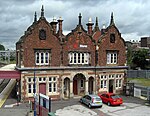Oulton Abbey
1624 establishments in Europe1853 establishments in England19th-century Christian monasteries19th-century Roman Catholic church buildings in the United KingdomBenedictine monasteries in England ... and 15 more
Benedictine monasteries in the United KingdomBenedictine nunneries in EnglandBuildings and structures in StaffordshireChristian monasteries established in the 17th centuryDefunct schools in StaffordshireE. W. Pugin buildingsGothic Revival architecture in StaffordshireHistory of Catholicism in EnglandHistory of StaffordshireMonasteries in StaffordshireMonasteries of the English Benedictine CongregationRecusantsReligious organizations established in 1625Religious organizations established in 1853Roman Catholic churches in Staffordshire

St Mary's Abbey, Oulton is a former Benedictine convent located in the village of Oulton near Stone in Staffordshire, England. The Abbey church is Grade II* listed, and other buildings are Grade II. The Benedictine community was founded in 1624 in Ghent, from a motherhouse established in Brussels in 1598 by Lady Mary Percy. In 1794 as a result of the French Revolution the nuns were forced to flee to England, settling initially in Preston, moving in 1811 to Caverswall Castle, Stoke on Trent.
Excerpt from the Wikipedia article Oulton Abbey (License: CC BY-SA 3.0, Authors, Images).Oulton Abbey
Convent Lane,
Geographical coordinates (GPS) Address Nearby Places Show on map
Geographical coordinates (GPS)
| Latitude | Longitude |
|---|---|
| N 52.9174 ° | E -2.1374 ° |
Address
Convent Lane
Convent Lane
ST15 8UN , Stone Rural
England, United Kingdom
Open on Google Maps







